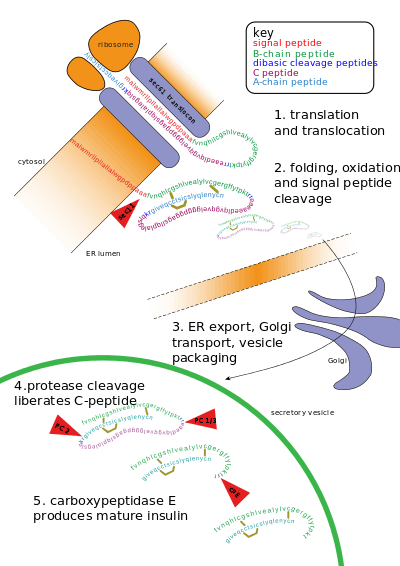Proinsulin
| insulin | |
|---|---|
|
Insulin undergoes extensive posttranslational modification along the production pathway. Production and secretion are largely independent; prepared insulin is stored awaiting secretion. Both C-peptide and mature insulin are biologically active. Cell components and proteins in this image are not to scale. | |
| Identifiers | |
| Symbol | INS |
| Entrez | 3630 |
| HUGO | 6081 |
| OMIM | 176730 |
| RefSeq | NM_000207 |
| UniProt | P01308 |
| Other data | |
| Locus | Chr. 11 p15.5 |
Proinsulin is the prohormone precursor to insulin made in the beta cells of the islets of Langerhans, specialized regions of the pancreas. In humans, proinsulin is encoded by the INS gene.[1][2]
Synthesis and post-translational modification
Proinsulin is synthesized on membrane associated ribosomes found on the rough endoplasmic reticulum, where it is folded and its disulfide bonds are oxidized. It is then transported to the Golgi apparatus where it is packaged into secretory vesicles, and where it is processed by a series of proteases to form mature insulin. Mature insulin has 35 fewer amino acids; 4 are removed altogether, and the remaining 31 form the C-peptide. The C-peptide is abstracted from the center of the proinsulin sequence; the two other ends (the B chain and A chain) remain connected by disulfide bonds.
Immunogenicity
When insulin was originally purified from bovine or porcine pancreata, all the proinsulin was not fully removed.[3][4] When some people used these insulins, the proinsulin may have caused the body to react with a rash, to resist the insulin, or even to make dents or lumps in the skin at the place where the insulin was injected. This can be described as an iatrogenic injury due to slight differences between the proinsulin of different species. Since the late 1970s, when highly purified porcine insulin was introduced, and the level of insulin purity reached 99%, this ceased to be a significant clinical issue.[5] It should also be noted that in respect of their influence on insulin pharmacokinetics, moderate concentrations of certain insulin antibodies may, in fact, be of positive advantage to all diabetics without endogenous insulin secretion (e.g. people with type 1 diabetes) because insulin binding antibodies effectively increase the insulin's clearance rate and distribution space and therefore helps to prolong its pharmacological and biological half lives.[6]
See also
- insulin
- preproinsulin
- signal peptide
- signal peptide peptidase
- proprotein convertase 1
- proprotein convertase 2
References
- ↑ "Entrez Gene: INS insulin".
- ↑ Bell GI, Pictet RL, Rutter WJ, Cordell B, Tischer E, Goodman HM (March 1980). "Sequence of the human insulin gene". Nature. 284 (5751): 26–32. doi:10.1038/284026a0. PMID 6243748.
- ↑ Wilson RM, Douglas CA, Tattersall RB, Reeves WG (September 1985). "Immunogenicity of highly purified bovine insulin: a comparison with conventional bovine and highly purified human insulins". Diabetologia. 28 (9): 667–70. doi:10.1007/BF00291973. PMID 3905477.
- ↑ Tanyolac S, Goldfine ID, Kroon L. "Insulin Pharmacology, Type of Regimens and Adjustments". Endotext.com. Retrieved 2011-03-18.
- ↑ Home PD, Alberti KG (November 1982). "The new insulins. Their characteristics and clinical indications". Drugs. 24 (5): 401–13. doi:10.2165/00003495-198224050-00003. PMID 6756879.
- ↑ Gray RS, Cowan P, di Mario U, Elton RA, Clarke BF, Duncan LJ (June 1985). "Influence of insulin antibodies on pharmacokinetics and bioavailability of recombinant human and highly purified beef insulins in insulin dependent diabetics". Br Med J (Clin Res Ed). 290 (6483): 1687–91. doi:10.1136/bmj.290.6483.1687. PMC 1416075
 . PMID 3924216.
. PMID 3924216.
